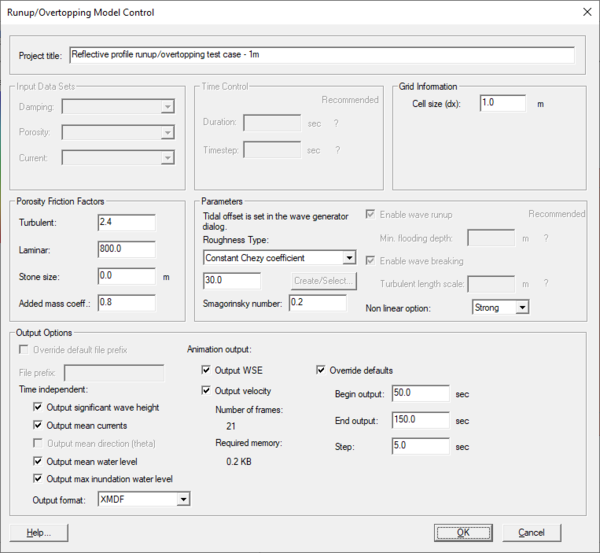SMS:BOUSS Runup / Overtopping Model Control
From XMS Wiki
(Redirected from SMS:BOUSS Run up Model Control)
Jump to navigationJump to search
The BOUSS2D Runup / Overtopping Model Control dialog is accessed by right-clicking on the Runup/Overtopping simulation and selecting the Model Control command. The dialog allows setting the following parameters:
- Project Title – Enter the title of the project in this field. The title is used for the folder name where the output files will be stored.
- Input Datasets – These inputs specify spatially varied input parameters for the model. In addition to the bathymetry, BOUSS-2D can utilize spatially varied damping, porosity and currents. In this section define whether these inputs are used (“None” is selected if not), and if so, how they are defined.
- Damping – specified using boundary conditions on cell strings or selected from the scalar functions.
- Porosity – specified using boundary conditions on cell strings or selected from the scalar functions.
- Current – selected from the available vector functions.
- Time Control – The interface displays the recommended values for Duration and Time step in parentheses.
- Duration – enter the model run duration.
- Time Step – enter the number of time steps for the model run duration.
- Grid Information – This section displays the attributes of the active grid.
- Cell Size – specifies the size of cells the model run will use.
- Porosity Friction Factors
- Turbulent – value ranges from 0.0 to 3.6 with a default value of 2.4.
- Laminar – value ranges from 0 to 1500 with a default value of 800.
- Store Size – represents the characteristic stone size (d50) in meters of the breakwater armor layer and must be greater than zero.
- Added Mass Coeff. –
- Parameters
- Roughness Type – sets the Chezy coefficient type. Currently, only "Constant Chezy coefficent" is allowed. The Chezy coefficient ranges from 0.0 to 1000.0 (default = 50).
- Smagorinsky Number – must be between 0.0 and 2.0 (default=0.2).
- Nonlinear Option – can be set to either "Strong" or "Weak".
- Output Options
- Overide Default File Prefix – allows specifying a file name for these solution files. The default file prefix is the filename of the *.par file.
- File Prefix – becomes active once the Overide Default File Prefix is toggled on. A new prefix may be entered when active.
- Time Independent
- Output Significant Wave Height
- Output Mean Currents
- Output Mean Water Level
- Output Max Inundation Water Level
- Output Format – gives options to output in an "XMDF" file, a "BOUSS-2D Native" file, or "Both".
- Animation Output
- Output WSE – tells the model to output time varying datasets.
- Output Velocity – tells the model to output time varying datasets.
- Number of Frames
- Required Memory
- Override Defaults – Enables the Begin Output, End Output, and Step controls.
- Begin Output – must be greater than 0.0 and less than the run duration.
- End Output– must be greater than 0.0 and less than the run duration.
- Step – determines how often the model will save time-varying output.
- Overide Default File Prefix – allows specifying a file name for these solution files. The default file prefix is the filename of the *.par file.
Related Topics
| [hide] SMS – Surface-water Modeling System | ||
|---|---|---|
| Modules: | 1D Grid • Cartesian Grid • Curvilinear Grid • GIS • Map • Mesh • Particle • Quadtree • Raster • Scatter • UGrid |  |
| General Models: | 3D Structure • FVCOM • Generic • PTM | |
| Coastal Models: | ADCIRC • BOUSS-2D • CGWAVE • CMS-Flow • CMS-Wave • GenCade • STWAVE • WAM | |
| Riverine/Estuarine Models: | AdH • HEC-RAS • HYDRO AS-2D • RMA2 • RMA4 • SRH-2D • TUFLOW • TUFLOW FV | |
| Aquaveo • SMS Tutorials • SMS Workflows | ||
